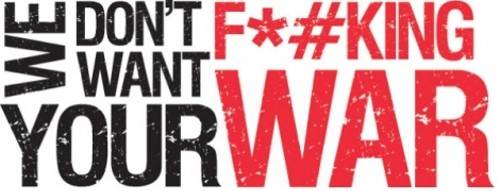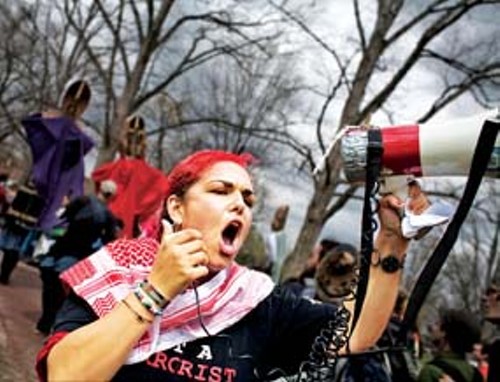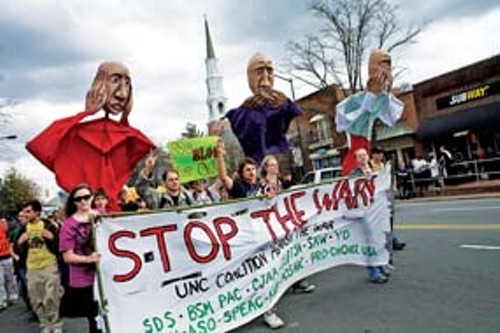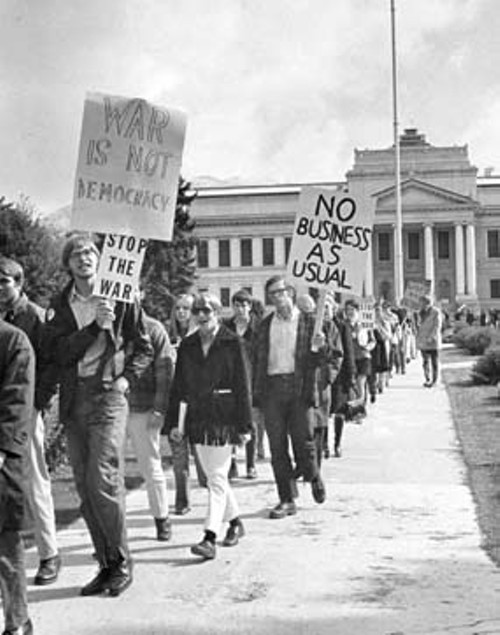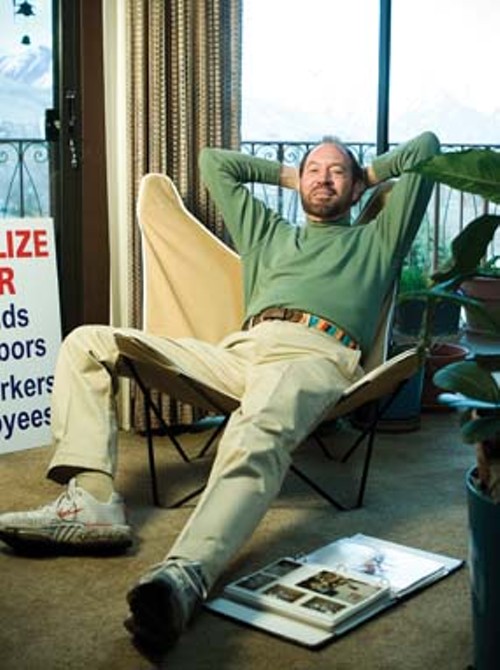Feature | We Don’t Want your F*#king War: Had enough? Sixties throwback Students for a Democratic Society returns to campus
By Lisa SorgThe man in the dark sunglasses snapping photographs in a springtime antiwar demonstration at University of North Carolina-Chapel Hill was working for the state-sponsored surveillance squad, ISAAC. And through his viewfinder, this dutiful employee of Information Sharing and Analysis Center, which operates out of the N.C. Attorney General’s office and the state’s Department of Crime Control and Public Safety, could watch entertaining, impassioned street theater: Ten-foot papier-mâché puppets towering over an Iraq War veteran delivering an emotional speech; Radical Cheerleaders leaping into the air while chanting catchy antiwar slogans; and a woman flying an Iraqi flag, which fluttered near the Students for a Democratic Society banner. And there was drumming, lots of drumming.
The protest, sponsored by the UNC Coalition Against the War and spearheaded by SDS, was one of 90 nationwide demonstrations held at college campuses and high schools last month [March ’08]. While many students scurried into the nearby Lenoir Dining Hall or watched passively from the sidelines, the 400 or so demonstrators who marched from campus through downtown Chapel Hill symbolized a victory for the local SDS chapter, arguably the most organized and outspoken anti-war group at UNC.
By taking the name SDS, the new generation of activists have refreshingly reinvigorated the radical spirit of their ’60s counterparts. Yet, the SDS and its 240 chapters are also inheriting their predecessors’ baggage: the ultimate failure to meet their goals. By the end of the 1960s, the original SDS had imploded due to infighting among its leadership. And its two pillars of protest, the Vietnam War and racism, continued; the former until 1975; the latter lingers into the 21st century.
“It’s useful to look at the old SDS as one of the best student organizations in the country,” says Ben Carroll, a UNC sophomore. “The spirit and the energy of the old SDS carries a great history, but we need to create a movement for today’s times rather than trying to recreate something from the past.”
The 21st-century SDS operates in a different era, against a different war, in a country with a different mindset. Unlike the Vietnam War, in which the supposed enemy was clear and, conveniently, distant, the Bush administration has framed the war in Iraq as “the global war on terror,” painting the opponent as an amorphous shape-shifter oozing through U.S. borders.
Without a draft to ignite national outrage, SDS is battling political complacency and nascence. A significant portion of Americans still believes Saddam Hussein was responsible for 9/11, according to a New York Times poll conducted in late 2007. And the idea of mobilizing around a common cause means camping in front of Wal-Mart for a post-Thanksgiving sale.
“People don’t have as direct of a stake in what’s going on,” says UNC junior Clint Johnson. “There is no draft, and that’s why we had the draft-card demonstration.”
In late February, SDS organized a mock recruiting station at UNC at which an Iraqi war veteran spoke about his combat experiences and protesters burned fake draft cards. Many onlookers seemed puzzled, as if a draft card were as quaint as a ration booklet from World War II.
“We’re all drafted in the sense that we’re responsible for what’s going on; it’s a de facto acceptance on the part of the public,” Johnson says. “Not having a draft hurts, in that people don’t have a real incentive. That puts the current movement on a different plane of morality; people are protesting despite the fact they’re not facing the draft themselves.”
Hostility vs. Indifference
Kostas Harlan remains an SDS member, even though he has graduated. “It wasn’t like, ‘Well, I’m done with that,’“ he says. “I feel a sense of responsibility for what’s taking place in Iraq.”
Dick Reavis, a former member of the original SDS, now teaches journalism at North Carolina State University in Raleigh. He was the adviser to that school’s SDS chapter, but it collapsed due to lack of interest. “I like it that a group of students came together to oppose the Iraq war and called themselves SDS, but I don’t think it has much other relevance,” Reavis says. “I think the kids are facing a harder situation. The ’60s were confrontational. The whole style of politics is now more indirect, ironic, reflective—not confrontational. [During the March protest] there was leafleting on campus; people were either hostile or indifferent. We did encounter hostility [in the 1960s]. But we never encountered indifference.”
The UNC-Chapel Hill chapter launched in September 2006, shortly before former U.S. Attorney General John Ashcroft’s speech on campus. Since then, the group, which has about two dozen members, has led rallies and demonstrations at UNC and at Chapel Hill’s military recruiting station, and occupied the local office of U.S. Rep. David Price, who voted against the war and has urged the president to set a timetable for troop withdrawal. (A Price staff member called police, who arrested the protesters. A Raleigh civil rights attorney represented the SDS members in court; trespassing charges were dropped.)
The protest at Price’s headquarters points to a larger disagreement between SDS and the Democratic Party. Just as ’60s activist and former California lawmaker Tom Hayden noted in his 1962 Port Huron Statement—the founding document of the SDS—the Democratic Party, particularly [the South’s] Dixiecrats, “tolerates the perverse unity of liberalism and racism, prevents the social change wanted by Negroes, peace protesters, labor unions, reform Democrats and other liberals.”
This division continues today, as the national SDS weighs whether to support the Democratic presidential candidates, particularly Barack Obama, even though he has consistently opposed the war. Many SDSers see little difference between Republicans and Democrats, contending the two-party system has stymied the American political system and discourse. “Some chapters are boycotting the election,” Carroll says. “Other chapters are running voter registration drives. This summer at the national convention, we’ll decide.”
The UNC Young Democrats were among the 14 groups that united for last week’s anti-war demonstration. “It made us a little uncomfortable,” Tamara Tal, a graduate student and SDS member, says. “We don’t endorse candidates or do voter registration. I see our role as to educate people about the real limitations of what the candidates stand for and why the two-party system isn’t working. The war isn’t going to end if Obama or Clinton is elected.”
Fear and Confrontation
Reavis is like the radical Forrest Gump of the last 40 years: Pinpoint a pivotal political moment, and he was likely in the middle of it. A Texan by birth, Reavis joined SDS after spending the Freedom Summer of 1965 as a civil rights worker registering black voters in Alabama. But even the SDS’s confrontational tactics initially frightened him.
“SDS scared me,” Reavis recalls. “A day or two after I joined, I saw a picture of some bearded guys in front of an airplane at ROTC holding a sign saying ‘The sole purpose of this machine is the destruction of human flesh.’ I thought, How over the top! What strange-looking characters. I was very hesitant, but with time, my views changed.”
Longtime SDS tactics—street theater, passive resistance, civil disobedience—can unnerve those unaccustomed to such outspokenness. Last November, at a demonstration at the Chapel Hill military recruiting station, SDS members defied police orders to stay on the sidewalk; no one was arrested. About a dozen members of the Gathering of Eagles—hawkish, self-appointed defenders of freedom (and national monuments)—confronted SDS with air horns and megaphones. “SDS is a Communist-based organization,” the Eagles yelled, inching closer to demonstrators.
“They say, ‘Get back,’“ chanted SDS members, undaunted. “We say, ‘Fight back.’”
As the protest headed downtown, the Eagles dispersed.
Both incarnations of SDS have faced critics questioning the effectiveness of demonstrations, noting the membership is primarily white, and painting their outrage as collegiate folly that can’t end the war.
Hannah Simmons, a senior, was among those skeptical about public protests, until she attended an antiwar demonstration last spring in Washington, D.C. “I used to think it was just people chanting and making themselves feel better. But then I realized that the power of feeling like you’re doing something with like-minded people and the strength that you get. It can be a stimulus to get more information and become more involved. It can be a very powerful thing.”
As for SDS’s racial mix, Tal acknowledges it is primarily, but not solely, white, and notes that the group often works with Latino and black student organizations on issues ranging from the war to collective bargaining to environmental justice.
“The same system that supports the war is the one that oppresses minorities,” Tal says. “We’re also struggling against oppression and whatever that means for minorities, we’re in solidarity with them.”
The original SDS didn’t end the war it protested; nor will the new SDS, alone.
“While SDS did some good, what made the Vietnam War unpopular is that we were losing,” Reavis says. “When veterans [came] home and told people what Vietnam was like, they did far more than we could to give that war a bad name. We did not end the war and they didn’t end the war. The Vietnamese did.”
“I don’t think it will be any one group that ends the war,” Simmons says. “That would be arrogant to say. But all these parts add up and the SDS plays an important role.”
Lisa Sorg is editor of the [N.C.] Independent-Weekly. This story is reprinted with permission.
Fired Up: Remembering U of U student activism.
Stephen Holbrook visited Calvin Rampton last year, not long before the legendary 93-year-old former Utah governor died. Rampton, Holbrook recalls, looked him squarely in the eye and asked:
“OK, Steve. The statute of limitations has long since passed. Who set the ROTC building on fire?”
Holbrook says he never told Rampton outright but allowed him to tick down a list of likely suspects and guess the culprit through a process of elimination.
Perhaps Salt Lake City’s most memorable 1960s anti-war activist, Holbrook wouldn’t tell City Weekly who burned the building in protest on May 6, 1970, either. “I’m no snitch,” he says with a laugh.
But, back in the day, he was what many in the pro-war, pro-Lyndon Johnson, pro-Richard Nixon establishment called a “radical.” Now 66, Holbrook has retired from a 45-year career of political activism, a span that includes early civil rights work in Mississippi; membership in the Students for a Democratic Society (SDS) and anti-Vietnam War demonstrations; three terms as a Democratic representative in the Utah Legislature and as a co-founder of KRCL community radio in 1979.
Political activism rarely raises to more than a low simmer these days at the University of Utah, so the image of the campus as a hotbed of protest 40 years ago seems mind-boggling. But it’s true. At the height of the Vietnam War—from approximately 1967 to 1972—students took part in burning their draft cards and between 4,000 and 5,000 of them (depending on the source) rallied on the lawn south of the A. Ray Olpin Union building on May 6, 1970—two days after National Guardsmen shot and killed four Kent State University students during an anti-war demonstration.
And as it was etched in Rampton’s mind (he was governor at the time), students did set fire to a World War II-era building that had long been vacant and slated for demolition. But it was the act itself that chapped members of the campus and state establishment.
“Those who chose to burn [the building] down knew there was no one inside,” Holbrook recalls. On the same day, about 800 students marched into the Park Building (the administration building) and sat down. Many of them left when informed they would be suspended from school, but a committed core stayed overnight. They were arrested the following day.
But Holbrook had been arrested years earlier. He takes a certain pride that he stood against the Vietnam War long before the protest movement took hold on campuses nationwide. “In 1964, eight of us went to the downtown post office. We were the ‘Induction Committee.’ They burned their Selective Service cards and were arrested at the door.
The college years proved a fascinating evolution for Holbrook, who grew up in a conservative family in Bountiful. He was steeped in Republican politics, once met President Dwight D. Eisenhower and attended the 1960 Republican National Convention, which nominated Richard Nixon to run against John F. Kennedy.
By 1963, having witnessed a march in Washington, D.C., memorializing slain civil rights worker Medgar Evers, Holbrook began to change his views. “In time, I realized how out-of-touch the powers that be were in regard to both the war and the civil rights movement,” he says.
In that way, he was much like millions of other ’60s-era college students. They had grown up steeped in the notion that America was the land of opportunity for all, and that political leaders could be trusted to make the right decisions. “And by the time the moratoriums of 1968 and ‘69 caught on, thousands of people at a time were getting involved,” Holbrook says. Dogs and fire hoses were being turned on black people in the South; the poor and undereducated were being drafted for Vietnam with no access to the deferments enjoyed by the wealthy.
“There was an obvious disconnect between what we say we are as a nation and who we really are. And we came to know that,” Holbrook says.
With a handful of modern SDS chapters springing up around the country, so far the U remains mostly uninvolved in any solid anti-Iraq War effort. Dustin Gardiner, a U senior who takes over the editorship of the Daily Utah Chronicle in May, believes the only way to shake up students is by reinstating the draft.
“I’m sure if more people had a personal stake in the war, we’d see more
activism,” Gardiner says. There are, he says, random student-led causes scattered around the campus. Many of them pop up in specific colleges and among extracurricular groups. A group known as Sustainable Environments and Ecological Design (SEED) is leading the charge and pushed for the recent establishment of a campus “sustainability office.”Beyond campus life, of course, there are committed peace activists—many of whom took a lesson from ‘60s protesters. Diana Lee Hirschi is a Salt Lake City Quaker and longtime pacifist. She participated in an April 5 anti-war protest downtown, one of many simultaneously held across the country.
Americans’ apathy toward an all-out antiwar effort isn’t exactly a mystery to her. “The neocons have been in control for too long, and it has been devastating for our democratic rights,” Hirschi says. “The Patriot Act comes to mind, and the concentration of media ownership. People can feel powerless against these things. I mean, how many more articles about piddly-assed shit between Hillary and Obama do we have to read?”
And laying blame strictly on students—charging them with apathy in opposing this war—is a bit harsh, she believes. “I don’t want to put too much pressure on young people in this effort. It’s a huge and horrible regime they’re up against. The current administration has made it clear they aren’t listening and don’t care what we think. It’s easy to get discouraged.
“But being discouraged is one thing. I hope they never get bitter.” —Holly Mullen
Latest in Cover Story
Readers also liked…
-
Forget the family pedigree—Robert F. Kennedy Jr should not be the next president of the United States
Trojan Horse
- Jun 21, 2023
-
Women decry harassment and toxic culture at St. George auto dealership
Men at Work
- Oct 11, 2023


